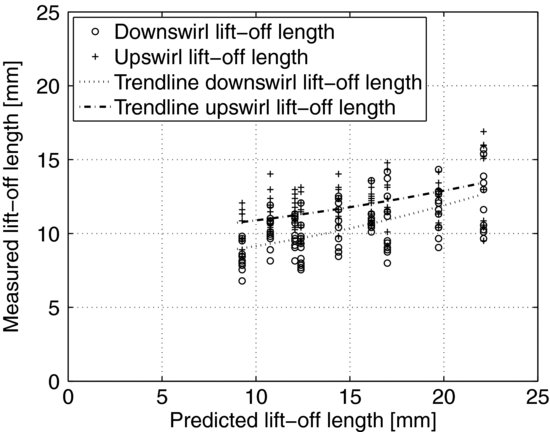12.3 Mathematical Analysis
To further investigate the nature of the relationships in your data you may continue with more quantitative, mathematical techniques, such as the ones presented in Chapter 8. When working with categorical data, the classical significance tests are often useful for demonstrating effects in a more unambiguous way than diagrams do. In this book we have only utilized the most fundamental tests. If these are not sufficient for your needs, the statistical literature contains a wealth of significance tests for various types of data.
For continuous numerical data, correlation and regression analysis are useful techniques for quantifying relationships between variables. Let us look at an example of how regression analysis was applied to strengthen the conclusions from Experiment 2.
Example 12.4: As explained in Chapter 10, the measured lift-off lengths in Experiment 2 were compared with an empirical formula, based on an extensive database from a spray chamber. According to this formula, the temperature, T, of the air surrounding the spray had a dominant effect on the lift-off length. More specifically, the lift-off length was proportional to T−3.74. In Experiment 2, the lift-off length shortened with increasing air temperature, but less than the empirical formula predicted. Regression analysis yielded a temperature exponent −1.55, substantially lower than the value of −3.74. The temperature dependence of the lift-off length was clearly weaker in the optical engine than in the spray chamber, indicating that the processes differed between these environments. To further support this conclusion, the observed lift-off values were plotted against those predicted by the empirical formula. The diagram is shown in Figure 12.4. The engine data obviously do not agree very well with the formula.![]()
Figure 12.4 Measured lift-off lengths plotted versus the ones predicted by an empirical formula. If the formula had applied to the measurements the points would have fallen on a line with a slope of one.

In this example, regression analysis was used to quantify the effect of a variable, just as we did when analyzing response surface experiments in Chapter 9. When compared to simply plotting the data, this mathematical analysis allows for a more unambiguous comparison of results between different experiments.
Before leaving mathematical analysis it could be useful to briefly mention multivariate data analysis. Data from experiments tend to be structured because experiments are designed to expose how one set of variables responds to structured changes in another. In some situations, however, we are faced with unstructured data. This situation could arise if it is impossible to control certain experimental variables independently of others. It is also common to search for relationships in large sets of historical data that are not the result of structured experiments. This could be a useful preparation for an experiment, as patterns in such data sets may help us to generate new hypotheses. (Remember that the research process is circular: analysis can serve as a preparation for the planning phase of an upcoming experiment.) Whenever we encounter unstructured data, multivariate techniques may be useful.
Multivariate techniques are statistical methods for investigating large sets of variables that are related to each other in ways that make it impossible to interpret their effects separately. A common approach is to look for a smaller set of underlying variables that summarizes the original ones. It is often possible to express most of the variation in the data set using a few orthogonal “dummy variables” that make it much easier to see relationships in the data. Unfortunately, a detailed discussion of multivariate techniques falls outside the scope of this book, but it is useful to know that they exist. If you think that they could be useful in your research, there are many textbooks on the subject to choose from. Hair, Anderson, Tatham, and Black [2] is one example that provides a useful overview.
